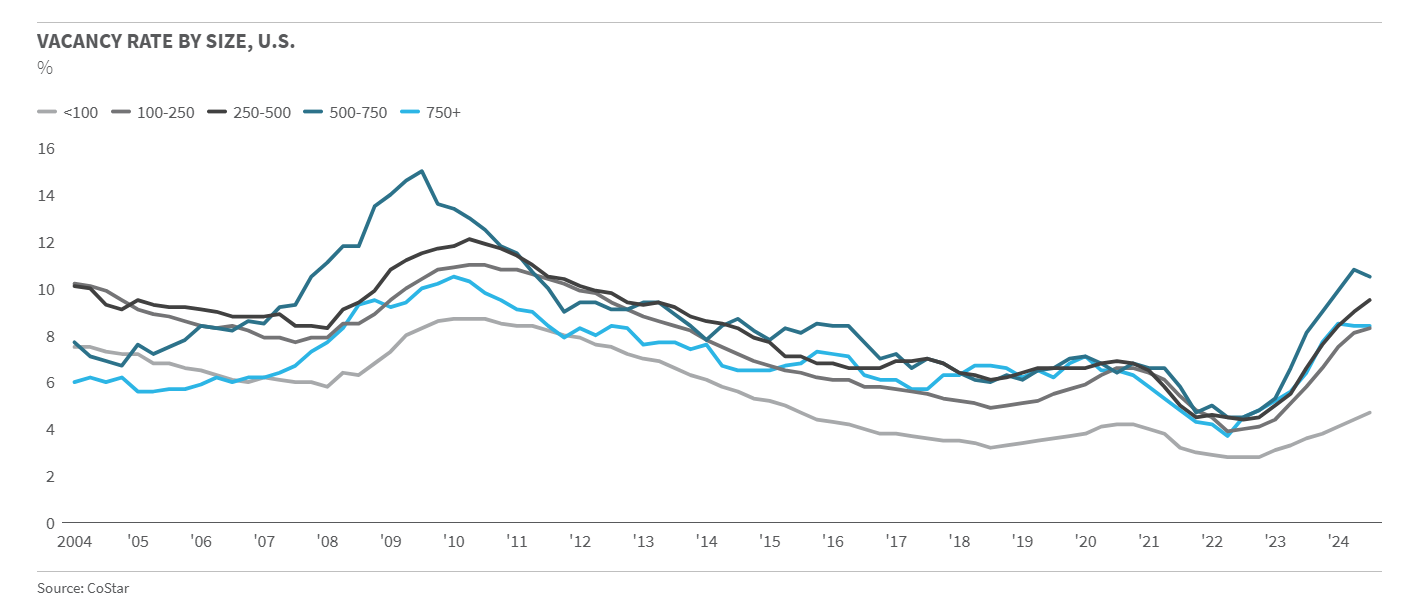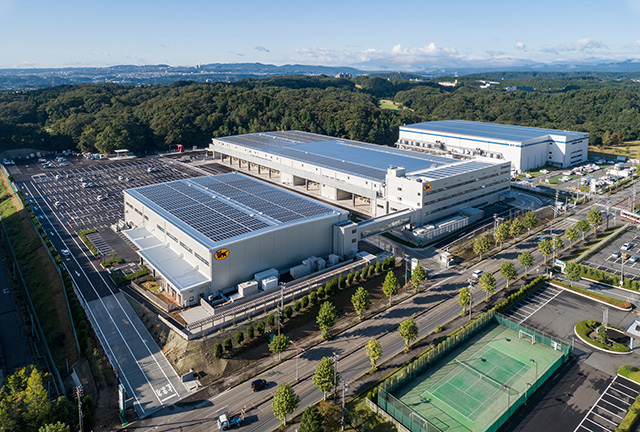
Prologis Research tapped into decades of industry experience, proprietary data, and unique property and customer insights to predict seven supply chain trends for 2025.
- Bulk space will rebalance first: Vacancy rates will fall the fastest for the largest buildings in U.S. and Europe. A combination of increasing demand and limited new supply will push vacancy rates down by 100 bps or more for buildings 500,000 square feet or larger.
- Freight will fly: Air cargo volume will surge by double digits, fueled by growing international e-commerce beyond China and the U.S.
- South America’s turn to take the stage: Brazil’s logistics real estate rent growth will surpass the global average by more than 500 bps as vacancy rates fall to never-before-seen mid-single digits.i
- All quiet on the construction front: Groundbreakings of logistics real estate buildings will decrease further in 2025, remaining 15% below normal globally.
- California’s domino effect: New legislation will seek to limit new supply in key locations. Following the passage of State Bill AB98 in California, we expect other states to propose similar measures in 2025.
- Better together: Freight industry consolidation will accelerate. M&A activity will intensify and drive technology investment and the next wave of expansion.
- What global trade slowdown? U.S. imports will grow faster than GDP despite new tariffs and the East Coast will take a larger share post-International Longshoreman Association (ILA) contract ratification.
In our 2024 predictions, we anticipated six out of seven key trends correctly, including a robust freight rebound, further slowdown in construction starts, outperformance in Latin America, continued investment in rooftop solar, a bounce in fundraising post-interest rate cuts, and the reversal of trends in global cap rates with expansion in Asia against compression in the U.S. and Europe. China stimulus, however, was delayed, and we did not see the recovery in domestic demand we expected, which will likely materialize later. (See more details about last year’s predictions at the end of this report.)
Trends of 2025
- Bulk vacancy rates (>500 thousand square feet) will fall by 100 bps or more in the U.S. and Europe. Resumed expansion by large users who delayed decision-making in recent years, coupled with an approximately 65% year-over-year drop in new bulk deliveries, will produce a scarcity of large logistics buildings in many markets by year-end.
- Groundbreakings for large bulk buildings soared during 2021 and 2022 to three times the typical levels in the U.S. and doubled in Europe. In 2024, development in this segment returned to pre-pandemic norms. Meanwhile, demand for large product is strong, averaging 26 million square feet per quarter over the past year in the U.S., 77% higher than the historical average. In other size segments, net absorption averaged 4 million square feet, 83% lower than the historical average.
- Strengthening business conditions should lead to the return of large logistics users and allow for sizeable space expansions. Bulk markets set to experience material declines in vacancies include Dallas, Atlanta and the Inland Empire.

Air cargo volume surges by double-digits, fueled by growing international e-commerce beyond China and the U.S.
- Global air cargo volumes rose 9.4% year-over-year in September, driven by 12% growth in Asia and 21% in Latin America.ii Both rapid growth in cross-border e-commerce and continued ocean shipping disruptions necessitated fast movement of goods between production and consumption locations, driving up air freight volumes.
- E-commerce penetration rates are expected to reach 24% worldwide and 26% in the U.S.iii The most active trade lane, Asia-North America, which comprised 25% of the global share of volume as of September 2024, will continue to drive growth, but we expect more evidence of e-commerce flows broadening around the world.
Brazil’s logistics real estate rent growth will surpass the global average by more than 500 bps as vacancy rates fall to never-before-seen mid-single digits.
- Brazil's logistics real estate market is maturing, but a challenging development environment has resulted in a severe undersupply of modern spaces (only 28% of São Paulo’s current inventory). At the same time, occupiers of modern logistics space are sophisticated and growing. Brazil’s expanding middle class demands higher service levels, reflected in e-commerce penetration rising from 3% in 2017 to 11% in 2024—driving an average demand for modern logistics real estate of 8.4% annually.
- Logistics real estate rents will grow more than 10% in 2025 as Class-A vacancy rates are set to fall another 240 bps to 6.8%, the lowest level in recorded history. With a construction pipeline that totals less than 1% of modern stock, market conditions could remain tight in Brazil for some time.
Groundbreakings of logistics real estate buildings will decrease further in 2025, remaining 15% below normal globally.
- Global starts declined by over 30% during 2024. Fewer projects broke ground because of the reduction in market rents affecting development economics, pullback in new capital for logistics real estate development and rising barriers to new supply, such as access to power infrastructure.
- The trajectory of development economics diverges by country. For example, construction materials costs are poised to decline slightly in the U.S. and Europe while construction costs increase in Japan and Latin America, where market rents continue to grow.
- New legislation will seek to limit new supply in key locations. In 2024, California passed State Bill AB 98, which imposes stringent development standards including sustainable development and community buffer zones. We expect other states to propose similar policies in 2025.
- Regulations like AB98 increase development costs, limit new construction, and can push logistics occupiers to less optimal transportation routes due to a lack of options and/or higher rents.
- In response, warehouse owners are investing in solar, battery storage, EV charging and sustainable construction materials to comply and future-proof buildings, driving up costs beyond the shell.
- California tends to lead in environmental and community-focused regulations. We expect other West Coast states, New York, New Jersey, Pennsylvania and Colorado to be among the first to propose similar restrictions. Conversely, markets with more business friendly development guidelines like Texas and the Southwest may continue to gain market share of development activity.
A wave of M&A in the freight industry will drive technology investments and the next wave of expansion.
- A favorable regulatory landscape, potential downward pressure on interest rates and significant dry powder will drive a new wave of deal-making in 2025. A steady growth profile will entice logistics companies to pursue acquisitions to expand market share in the absence of major tailwinds. Global deal volume in the freight industry reached $7.8 billion as of Q3 2024, compared to $13.1 billion in 2023, and we expect it will eclipse that number in 2025.iv
- Investments in technology—whether through direct acquisitions of tech companies or acquiring businesses with advanced logistics capabilities—can improve space utilization and fleet efficiency. Integrating artificial intelligence and machine learning will further enhance supply chain execution, positioning companies to capitalize on the sector’s evolving demands.
Import volumes for East Coast ports will bounce back after ratification of the International Longshoremen's Association (ILA) contract.
- In 2024, import volumes grew at less than half the rate for East Coast ports (approximately 10%) in comparison to West Coast ports (approximately 25%). We expect this dynamic to reverse in 2025. The strike reinforces that labor dynamics remain a risk to the smooth functioning of supply chains, which we predicted in 2021.
- Ratification of the ILA contract in January will clear the way for rising volumes in 2025. The New York-New Jersey port complex is integral to the global supply chain—serving a population of 190 million in adjacent states—and the Port of Houston is an essential manufacturing gateway to international markets, suppliers and producers.
- The anticipated resolution of contract disputes will boost confidence and operational efficiency, recapturing volumes that shifted westward during the uncertainty. With this stabilization, East Coast ports will experience renewed activity, reversing the recent slowdown and contributing to a rebalanced supply chain across the U.S.
Conclusion
These seven predictions are based on insights from our unique global platform, and we’ll revisit them at year-end. Our outlook highlights 2025 as a year of renewed activity, laying the foundation for the continued evolution of global supply chains set against challenging supply-side economics for the built environment. As always, companies that stay ahead of what’s next are best positioned to capture new sources of growth.
What did we get right and wrong in 2024?
✓ The global freight recession will reverse, demonstrated by double-digit growth in port and truck traffic.
- Landed TEUs grew 12% year-over-year in September and on-water TEUs grew 18% through November, continuing the reversal that began in the spring. West Coast trade volumes grew 26% year-over-year in September.
✓ The great construction bust will intensify, with global starts hitting the lowest level since the 2008 financial crisis.
- Global starts declined 30% year-over-year through Q3 and are expected to decline further with the arrival of Q4 data.
- Starts did not reach post Global Financial Crisis (GFC) lows, but they remain in the 2015-2019 range, depending on the country.
✓ Latin America rents will grow at more than double the global average, driven in part by nearshoring.
Latin America will end the year with mid-single digit rent growth while rents declined in a similar magnitude globally.
X Annual demand in China will reach the second-highest level on record, helping work through excess supply from the past few years.
Net absorption is expected to be moderate, approximately 60 million square feet in 2024, as sluggish economic activity and low consumer spending weighed on demand for Chinese logistics real estate.
✓ Technology, especially artificial intelligence, will drive up energy requirements in logistics facilities, incentivizing warehouse owners to double solar capacity.
Energy demand continued to rise as warehouses needed more power for EV fleets and the solar and battery requirements to run automation and daily operations.
✓ Interest rate declines will double private equity real estate funding in 2024. (We are taking a bull case on interest rate cuts.)
- The Fed, ECB, Banco de México, Bank of England and Banco Central do Brasil all cut rates in 2024, setting the stage for increased investor confidence moving forward.
- Fundraising for private equity logistics real estate accelerated swiftly toward year-end, gathering solid momentum to carry into 2025.
✓ Cap rate movements will reverse. U.S. and European cap rates will compress while expansion rotates to Asia.
Cap rates peaked in Q1 2024 at 5.5% in the U.S. and 4.8% in the UK and Europe combined. Both regions saw 10 bps decreases by year-end. Cap rates ticked up in China and Japan, despite divergent monetary policy.


